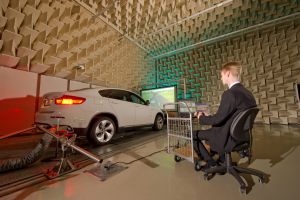Requirements on vehicles are increasing and their development becomes more and more complex, no matter, whether they are driven by a combustion engine or by a hybrid or electric drive. An approach to efficient development is the integrated product development model (iPeM) of IPEK, the Institute of Product Engineering of KIT. The central element of iPeM is early and efficient validation: The confirmation of a product fulfilling the function envisaged and expectations of the customers. Support is provided by the X-in-the-Loop instrument that combines simulations with real tests.
“It is a very difficult process to reconcile all requirements in vehicle development,” says Sascha Ott, Head of IPEK’s Division of Power Train Development and Managing Director of the KIT Mobility Systems Center. “For example, it is focused on optimizing fuel consumption and vibration development and on implementing new driving strategies. At the same time, the vehicle is to have a long durability under changing environmental conditions and changing driving styles.” iPeM represents a systematic, holistic approach to complex product development. It combines the view of developers with the economic or political framework conditions to be considered by the management of an enterprise. Product development processes may differ, but they also have common features like the finding of ideas, production, or commercialization. “A central activity is validation,” says Ott. “This means to check what the system is supposed to do and whether the ideas really work? We want to find out whether we are working on the right idea.” This is also important for economic reasons: “Recall actions quickly cause extreme costs. We can contribute to reducing this risk and to improving development success.”
Engineers using the validation environment X-in-the-Loop (XiL) are supplied with the necessary information at a very early stage of product development. XiL works on various levels from individual components, e.g. the clutch to partial systems, e.g. the gear system, to the complete vehicle. Depending on the component “X” to be studied, the engineers use real tests in one of the test beds, simulations, or a combination of both. “Friction processes in the clutch are studied in the test bed, because it is still difficult to model them in simulation. The remaining vehicle, however, can be simulated,” explains Sascha Ott.
XiL was originally developed for power trains, but it can also be transferred to other vehicle components. Among others, scientists use this environment to test vibration and noise development (NVH phenomena). “A good sound of a vehicle is a good argument in sales,” says Sascha Ott. “It also affects fuel consumption: The driving sound is to support the driver in choosing an operation point associated with favorable consumption characteristics.”
Apart from technical systems, XiL also considers environmental conditions, such as external temperature, routing, and traffic situations as well as different driver models and driving maneuvers. This makes it an important instrument in facing future challenges in the automotive sector: “Interactions become more and more complex. In addition, many different systems exist in parallel,” emphasizes Ott. “Several options exist as to what the car may look like in 20 years from now.” For instance, the design of the power train will depend on whether the battery of an electric car will always be in the vehicle or used for other applications as well. “It is our job to provide knowledge-based and highly flexible and transferable methods.”
35 engineers are working in the research division headed by Sascha Ott. About 40 person-years so far have been spent for the development of X-in-the-Loop. Research at IPEK is directly incorporated in teaching: Student papers and diploma theses are written and projects are carried out, in which students validate their concepts on different levels.
The Mobility Systems Center pools KIT activities relating to vehicle technology. Presently, 40 institutes with about 800 employees are working on methodological and technical fundamentals for tomorrow’s vehicles. It is their objective to develop energy-efficient, low-emission, and safe vehicles and mobility concepts. The researchers also consider the complex interactions of vehicle, driver, traffic, and society.
Under the heading of “Future Mobility”, KIT will present its scientific activities on its new “Campus East – Mobility and Innovation” during an Open Day on July 02. More information can be found at: www.pkm.kit.edu/3072.php
In close partnership with society, KIT develops solutions for urgent challenges – from climate change, energy transition and sustainable use of natural resources to artificial intelligence, sovereignty and an aging population. As The University in the Helmholtz Association, KIT unites scientific excellence from insight to application-driven research under one roof – and is thus in a unique position to drive this transformation. As a University of Excellence, KIT offers its more than 10,000 employees and 22,800 students outstanding opportunities to shape a sustainable and resilient future. KIT – Science for Impact.

